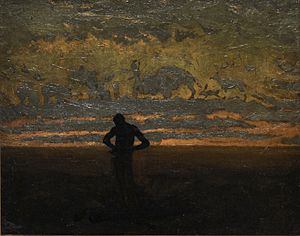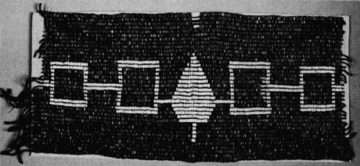Hiawatha facts for kids
Quick facts for kids
Hiawatha
|
|
|---|---|

Hiawatha, an 1874 painting by Thomas Eakins
|
|
| Born | Twelfth century (or fifteenth century) Onondaga
|
| Died | 12th century (or 15th century) Haudenosaunee
|
| Nationality | Onondaga, Mohawk, Iroquois |
| Known for | Cofounder and leader of the Iroquois Confederacy |
Hiawatha (pronounced HY-ə-WOTH-ə or WAW-thə), also known as Ayenwatha, was an important Native American leader from long ago. He helped create the Haudenosaunee Confederacy, also known as the Iroquois Confederacy. He was a leader of either the Onondaga people, the Mohawk people, or both. Some stories say he was born Onondaga but later joined the Mohawks.
Contents
Who Was Hiawatha?
Hiawatha was a real person, but many stories about him are legends. These legends tell us about his journey to bring peace. Historians believe the events in his legend happened around the mid-1100s. This was when the Iroquois Confederacy was founded.
The Legend of Hiawatha
The legend of Hiawatha is a powerful story of change and peace. It tells how he helped unite different Native American nations.
Meeting the Great Peacemaker
When Dekanawidah, known as The Great Peacemaker, first came to the Iroquois lands, he met Hiawatha. At that time, Hiawatha was living a difficult life. He was known as "the man who eats humans" because he had lost his way. Dekanawidah found Hiawatha in his cabin. He looked down through the smoke hole and saw Hiawatha's reflection in a cooking pot. Hiawatha saw the reflection too, thinking it was his own face. He saw beauty, wisdom, and strength in it. This made him feel ashamed of his past actions.
Dekanawidah then spoke to Hiawatha. He shared the Great Law of Peace with him. Hiawatha accepted this message of peace. He agreed to work with his own people. Dekanawidah continued his journey to share the message with other nations.
Overcoming Challenges for Peace
The main chief of the Onondaga people at that time was a cruel leader named Tadodaho. Legends describe Tadodaho as having a twisted body and mind. It was said his hair was full of living snakes. Dekanawidah asked Hiawatha to help Tadodaho change. He told Hiawatha to "comb the snakes out of [Tadodaho's] hair." This is how Hiawatha got his name, which means "he who combs."
Hiawatha tried to bring his ideas of peace to the Onondaga councils. However, Tadodaho always stopped his efforts. Hiawatha faced terrible sadness after losing his family members. Some believed Tadodaho's magic caused these losses. Full of grief, Hiawatha left his village. He wandered, creating special wampum strings. He hoped to find someone who could understand his deep sorrow.
Finally, he reached the Mohawk territory. There, Dekanawidah had already shared his message of peace. Dekanawidah performed a special ceremony for Hiawatha. He spoke words of comfort and healing. After this, Hiawatha joined Dekanawidah. Together, they wrote the laws of the Great Peace. They also created a Peace Hymn.
Hiawatha and Dekanawidah then visited the other four nations. They easily convinced the Oneidas and Cayugas. The Senecas were divided, but a solar eclipse helped persuade them. The Onondagas were harder to convince because they feared Tadodaho. But with the help of the other nations, and by offering Tadodaho a leadership role, they succeeded. Tadodaho's mind became clear, and Hiawatha "combed the snakes out of his hair."
Building the Iroquois Confederacy
Hiawatha was known for his excellent speaking skills. He shared a powerful message of peace. Dekanawidah, a spiritual leader, wanted to unite the Iroquois peoples. They shared common ancestors and similar languages. However, Dekanawidah had a speech impediment. This made it hard for him to spread his message.
Hiawatha became Dekanawidah's spokesperson. He was very good at convincing the Five Nations to accept the vision of peace. They banded together to form the Iroquois Confederacy. The original five nations were the Mohawk, Onondaga, Oneida, Cayuga, and Seneca. Later, in 1722, the Tuscarora joined, making it the Sixth Nation.
Hiawatha and Dekanawidah created the Great Law of Peace. This law was recorded in wampum belts. It helped strengthen the bond between the nations. Tadodaho eventually became the principal chief. Onondaga became the capital of the Grand Council, the main governing body. Hiawatha's legacy lives on through stories, songs, and books.
The Hiawatha Belt: A Symbol of Unity

The Hiawatha Belt is a special wampum belt. It represents the peace and unity among the original five nations of the Iroquois.
What is a Wampum Belt?
Wampum belts are made from black or purplish and white beads. These beads come from shells. In the Northeast of America, quahog clam shells are often used for the dark beads. Various types of whelk shells are used for the white beads. Wampum belts were used for records, ceremonies, and to show agreements.
The Hiawatha Belt shows the nations in a specific order. From left to right:
- The Seneca, known as the Keepers of the Western Door.
- The Cayuga.
- In the center, with a different symbol, is the Onondaga. They are the Keepers of the Central Fire.
- The Oneida.
- Finally, the Mohawk, the Keepers of the Eastern Door.
A white line connects all the symbols. This line shows the strong unity of the Iroquois. It also represents the Great Law of Peace and the entire Iroquois Confederacy.
The Belt's Meaning Today
The story of the Hiawatha Belt is connected to Hiawatha's own journey. When Hiawatha was filled with sadness, the Great Peacemaker gave him whelk shells. He told Hiawatha to place them on his eyes, ears, and throat. These shells were a sign of healing and purity. Hiawatha used these shells to help create unity. The Iroquois Nation believes the Peacemaker gave them the first wampum belt. This belt later became known as the Hiawatha Belt.
Today, the image of the Hiawatha Belt is proudly displayed on the Flag of the Iroquois Confederacy.
Hiawatha in Literature: A Different Story
In 1855, the famous poet Henry Wadsworth Longfellow wrote an epic poem. It was called The Song of Hiawatha. This poem tells the story of a hero with the same name. However, this fictional Hiawatha is not the same as the historical leader.
Longfellow likely used the name Hiawatha for his poem's hero. But he based the character on an Ojibway demigod named Manabozho. The poem tells a legendary story of a Native man. It covers his birth, many battles, losses, and moral lessons. Longfellow and another writer, Henry Rowe Schoolcraft, wanted to share Native American stories. They hoped to create pride and remembrance for Native Americans.
See also
 In Spanish: Hiawatha para niños
In Spanish: Hiawatha para niños
- Hiawatha, Iowa
- Hiawatha, Kansas
- List of peace activists

